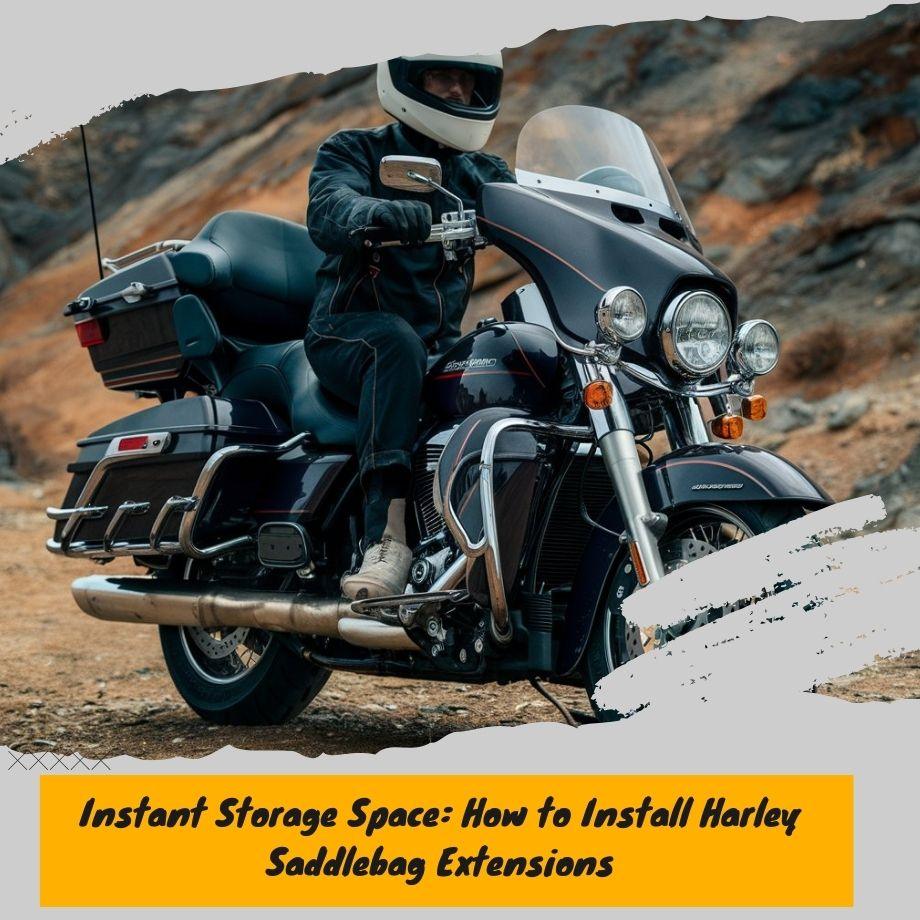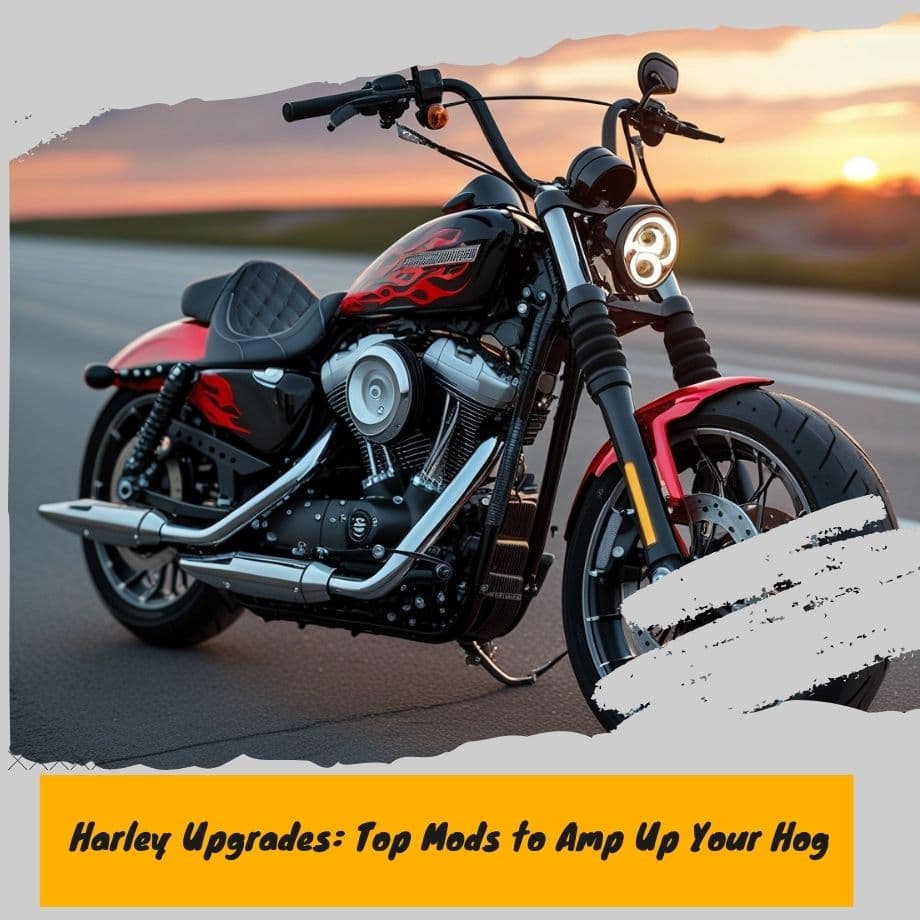Instant Storage Space: How to Install Harley Saddlebag Extensions

Harley-Davidson motorcycles are known for their iconic styling and customization.
Adding saddlebag extensions, which increase the storage capacity of the stock saddlebags, is one popular customization. This allows riders to carry more gear for long trips.
The stock saddlebags on many Harley models are large enough for everyday use but can feel small for extended touring. Harley Saddlebag extension is a simple bolt-on modification that can add several inches of width to each bag. This provides substantial extra packing space without compromising the bike's clean lines.
In this guide, we'll cover the complete process of installing saddlebag extensions on a Harley-Davidson Touring model.
We'll go over important safety steps, including assessing your current bags, prepping the bike, installing extension frames and panels, reassembling removed parts, and final checks.
We'll also provide tips for getting the most out of your new extended saddlebags.
With some mechanical skills and the right tools, you can do this project in your home garage. So let's begin the transformation of your stock Harley bags into more capable touring luggage.
Safety Precautions
Installing saddlebag extensions on a Harley-Davidson motorcycle requires proper preparation and safety measures. Here are some precautions to take:
Tools and Equipment
- Socket wrench set
- Hex key set
- Torque wrench
- Clean rags
- Motorcycle lift or rear stand
- Protective gear - gloves, eye protection, closed-toe shoes
Make sure you have the proper tools for removing and reinstalling components. Use a torque wrench to tighten the hardware to factory specifications.
Preparing the Motorcycle
Allow the engine and exhaust system to fully cool before beginning work.
- Stabilize and lift the motorcycle so it does not tip over. Employ a lift or rear stand specifically designed for motorcycles.
- Remove the seat and any accessories blocking access to the saddlebags.
- Clean the saddlebag area thoroughly before disassembly.
Proper stabilization and cleaning allow for safe access to install the extensions.
Safety Gear
Wear appropriate protective gear when working on the motorcycle:
- Sturdy gloves to protect your hands from sharp edges
- Eye protection such as safety glasses
- Closed-toe shoes to avoid foot injuries
This gear protects from common hazards encountered when working with motorcycle components.
Take your time and work cautiously when installing saddlebag extensions. Focusing on safety helps prevent injury.
Assess Current Saddlebags
Before installing saddlebag extensions, you'll want to closely inspect your existing saddlebags to make sure they are in good condition and will properly support the additional weight and size of the extensions. This assessment will also help determine the correct extension set for your bike.
Inspect for Damage or Issues
Carefully look over the entire saddlebag assembly for any cracks, dents, warped or bent areas, loose rivets or hardware, or other signs of damage or wear. Pay extra attention to the mounts, hinges, latches, and any welded seams.
Even minor flaws or weaknesses can worsen under the increased load, so it's best to repair or replace any compromised components beforehand.
Measure to Find Extension Fit
Take precise measurements of your saddlebags' dimensions including length, width, height, radius of any curved surfaces, and distance between the bags.
Compare these measurements against the product specs of potential extension kits to find the best fit. Most extensions are designed for specific Harley models, but you'll want to verify proper sizing.
Determine Attachment Method
Study how your saddlebags connect to the motorcycle. Most attach with bolts, brackets, or strong welds. Make note of any specific hardware or joint types that the extension frames will need to match up with.
Some extension kits clamp on while others may require drilling holes. Understanding the stock mount style will ensure you get extensions that properly attach.
You May Also Like To Know: ROCKING ROAD KING SADDLEBAGS
Thoroughly inspecting and measuring the saddlebags first will make installing extensions much easier down the road. It also prevents wasting money on extensions that don't actually fit your bike model or worn out bags that can't handle extensions safely.
Prep the Motorcycle
Before installing the saddlebag extensions, you'll need to prep the motorcycle to provide access and protect the paint. Here are the key steps:
- Cover painted surfaces that may get scratched during the install. Use painter's tape, soft cloths, or towels. Pay extra attention to protecting the rear fender paint.
- Remove the seat and any components blocking access to the saddlebag mounting points. This usually includes detaching the sissy bar, backrest, and any attached luggage racks or bags. Consult your owner's manual for proper removal procedures.
- Detach the saddlebags themselves so you have open access to the bag mounts and attachment points. Again, refer to your owner's manual for the recommended process to remove stock saddlebags.
- Remove any body panels or covers that may hinder access to the saddlebag mounting area. This depends on your specific motorcycle model but may include side covers, rear side panels, or rear lighting components.
- If your bike has any wire harnesses or cables running along the saddlebag mounts, use zip ties to temporarily secure them out of the way during the installation. Be careful not to over-bend or kink any wires.
- Lastly, thoroughly clean the saddlebag mounting points to ensure proper adhesion of the extension frames. Remove any dirt, grease, or debris with isopropyl alcohol.
Install Extension Frames
Installing the extension frames is one of the most crucial steps in the saddlebag extension process. You'll need to decide whether to bolt on new extension frames or weld them.
Bolting on extension frames is easier and doesn't require welding equipment or expertise. Using the provided hardware (WHAT IS SADDLEBAG HARDWARE?), simply bolt the new frames onto the existing saddlebag frames. Make sure to use lock washers or thread lockers to prevent the bolts from loosening over time.
Welding the frames requires more skill, but it can provide a stronger, more integrated frame extension. Before welding, make sure to thoroughly clean and prepare the surfaces that need joining.
Before completing the welds, tack-weld the extension frames in place, ensuring proper alignment. Allow the welds to cool completely before continuing installation.
Proper alignment of the extension frames is critical, whether bolting or welding. The frames should match the angle and position of the original saddlebags without sagging or twisting.
Misaligned frames can lead to issues with bag clearance and appearance. Check alignment from multiple angles before finalizing the extension frame installation.
With the frames securely installed, you're ready to mount the saddlebag extensions and complete the installation. To avoid problems down the road, take your time with the frame installation.
Attach Saddlebag Extensions
Attaching the saddlebag extensions is one of the most important steps in the installation process. Take your time to ensure a secure fastening and proper alignment of the extensions.
Start by holding the extension up to the saddlebag frame or existing saddlebag. Most extensions will have pre-drilled holes or marks showing where to attach them. Line these up with the corresponding marks on the frame/saddlebag.
If there are no pre-drilled holes, you'll need to mark where screws should go. Make sure to mark the frame/saddlebag and extension so the holes will align. Use a drill to create holes in both pieces.
With holes aligned, insert screws through the extension and into the frame/saddlebag. Use the appropriate sized bolts or screws for your hardware. Tighten down screws evenly until the extension is firmly secured. Be careful not to overtighten.
Check that the extension is centered and sits flush against the saddlebag. Look from all angles to ensure proper alignment. If needed, loosen screws and adjust until aligned.
Once properly positioned, tighten all screws firmly and evenly. Give the extension a final check by trying to jiggle or move it - it should be completely secure with no wobble or shifting.
Proper installation here is key for safety, security, and aesthetics. Taking the time to securely fasten and align the extensions will lead to a clean look and prevent issues down the road. Ride safe!
Reinstall Removed Components
To improve access during the installation process, you'll need to reinstall any parts you removed after installing the saddlebag extensions. This is an important step, as leaving components off can affect the safety and operation of the motorcycle.
- Replace the seat if it was removed. Make sure it clicks securely back into place.
- Reinstall any covers or side panels that were taken off. Again, ensure they are securely fastened.
- If you had to detach any wiring, hoses, or cables, carefully reattach them. Verify the connections are tight and properly routed.
- Double check that all fasteners removed like bolts or screws are replaced in their original locations. Confirm they are tightened to the proper torque specifications.
- Give the bike a quick once over to make sure no tools or rags were left behind. Also inspect for any leaks or issues caused by the installation.
Taking the time to correctly reinstall all the parts you removed will ensure your Harley functions properly and safely after adding saddlebag extensions.
Final Safety Checks
After installing the saddlebag extensions, it's crucial to do some final safety checks before riding to ensure everything is properly installed.
- Visually inspect the extensions to confirm they are securely attached to the saddlebags with all necessary hardware properly tightened. Try gently pulling on the extensions to verify they don't detach.
- Ensure the saddlebags can fully open and close without any interference from the extensions.
- Check that the extensions don't block access to any controls, lights, signals, or components on the motorcycle.
- Sit on the motorcycle and lean side-to-side to confirm adequate clearance between the extensions and legs.
- Start the engine and take a short test ride in a safe area. Accelerate, brake, and lean into turns to verify normal motorcycle operation and handling.
- Listen and feel for any rattling or vibration from the saddlebag extensions. Immediately stop if you detect any issues.
- When parked after the test ride, do a final visual inspection of the extensions to check for any shifting or loosening of hardware. Retighten if needed.
Taking the time to thoroughly test and inspect the saddlebag extensions after installation is critical. Only ride once you've confirmed safe and secure attachment.
You May Also Like To Know: How to Open Harley Saddlebags Without a Key
Monitor the extensions closely on initial rides and retighten hardware if any loosening occurs. Routine inspections help ensure safe long-term use.
Tips for Use
When using saddlebag extensions, keep these tips in mind:
Max Weight Limits
- Check the manufacturer's specs for the max weight the extensions can hold. Overloading can damage the bags or cause handling issues.
- Aim to evenly distribute weight between both sides. An imbalanced load can make the bike harder to handle.
- Weigh bags individually before loading the bike to ensure even weight distribution.
Packing Tips
- Use soft luggage designed for motorcycles rather than rigid boxes. Soft bags conform to the extensions better.
- Pack heavier items low and centered in the bags. Too much weight up high can raise the bike's center of gravity.
- Make sure no straps or items extend outside the bags, which could contact the wheels.
- Check that bags do not rub against moving parts, as this can cause wear.
Security Recommendations
- Always keep bags securely latched while riding. Consider using padlocks for better security.
- Remove any valuables from bags if leaving the motorcycle unattended.
- Park in visible areas and use a bike cover to conceal expensive saddlebags.
- Engrave or mark bags with identifying information in case they are stolen.
Conclusion
Installing saddlebag extensions on a Harley-Davidson motorcycle can expand your storage capacity for longer trips. This guide has walked through the key steps to safely install extensions and modify your saddlebags.
When installing extensions, always take precautions like stabilizing the motorcycle, disconnecting the battery, and avoiding pinch points. Carefully remove the necessary components to access the saddlebag frame and prepare the surfaces.
Follow the extension kit instructions to securely mount the new frames and panels. Reinstall all the original parts once the extensions are in place.
Before riding, do final safety checks and test the extensions at low speeds. During your initial rides, pay close attention to the new extension parts. Properly installed saddlebag extensions should be stable and allow easy access to storage space.
For additional guidance, refer to Harley-Davidson's owner's manuals and check forums dedicated to Harley motorcycle modification.
Expert H-D mechanics can also provide advice on saddlebag extensions and compatibility for your bike's model and year.
Expanding capacity takes some work, but it can greatly improve the utility of your Harley for cross-country rides.







Leave a comment